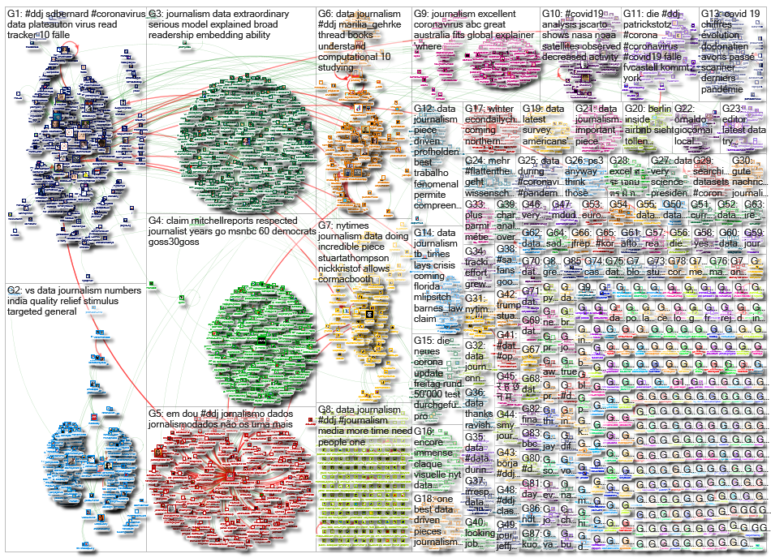The coronavirus pandemic has sparked an array of interactives, charts, and simulations by data journalists and citizens around the world. This week’s NodeXL #ddj mapping from March 23 to 29 finds The New York Times warning of the dangers of ending social distancing measures by Easter, Germany’s Der Spiegel and Der Tagesspiegel measuring traffic levels and COVID-19 cases respectively, the Tampa Bay Times monitoring Florida’s growing peril, Kevin Simler making an interactive simulation to explain how general epidemics unfold, and Mona Chalabi creating a viral TikTok video on Mark Zuckerberg’s donation to advance coronavirus research.
Dangers of Ending Social Distancing
US President Donald Trump alarmed health experts by saying he hoped to end social distancing measures by Easter. The New York Times developed an interactive model with epidemiologists to show why returning to normal routines too quickly could lead to an explosion of infections, hospitalizations, and deaths. The Times is also attempting to track every coronavirus case in the country, and released its dataset of coronavirus cases to the public. Looking for more COVID-19 datasets? Try Google’s Dataset Search.
An epidemiological model suggests that opening the country up at Easter, as President Trump wants to, rather than two weeks later would kill an additional 450,000 Americans https://t.co/um9NI8ZzjT
If you want to reopen the economy, you need widespread testing first
— Ana Swanson (@AnaSwanson) March 26, 2020
German Traffic in the Time of Corona
Political leaders in Germany have not enacted curfews like many other nations, but they have imposed extensive nationwide exit restrictions and strict limits on social gatherings. Der Spiegel analyzed data from Hystreet’s laser scanners, the TomTom Traffic Index, and Eco Counter to measure pedestrian, vehicle, and bicycle traffic.
Germany has not enforced a strict curfew from one day to the next. Instead, we have seen a gradual tightening of measures. This is how it inflicted public life:https://t.co/XiXGDT1YcT (article in German)#ddj with @A_Tack & @angela_oe (1/3) pic.twitter.com/DS2gkAnFZ5
— Patrick Stotz (@PatrickStotz) March 25, 2020
Florida’s Worrying Progression
As of March 31, Florida remained one of the few US states with a large outbreak without a statewide order keeping residents at home. According to a Tampa Bay Times analysis, the rate of increase in the number of confirmed coronavirus cases in the state puts it on a trajectory to see tens of thousands of infections in coming weeks. Experts say the number of cases is already past the point of easy containment.
"The number of confirmed coronavirus cases in Florida is doubling every three days. Florida remains one of the few states with a large outbreak not to issue a statewide order to keep residents at home."https://t.co/KDh6yYQ4ky
— Rachel Maddow MSNBC (@maddow) March 30, 2020
How Epidemics Unfold
Kevin Simler, co-author of “The Elephant in the Brain: Hidden Motives in Everyday Life,” tried his hand at creating an interactive simulation of a disease outbreak. His caveat: The grid simulations are not an attempt to model COVID-19, but a simplified model of how general epidemics unfold.
OUTBREAK — 🆕 interactive essay
Explore travel restrictions and social distancing. Learn how #FlatteningTheCurve reduces fatalities. All with playable simulations.https://t.co/ojCpNLnOvl pic.twitter.com/bZicBYtSLx
— Kevin Simler (@KevinSimler) March 16, 2020
Tracking Coronavirus Cases in Germany
Der Tagesspiegel is tracking all confirmed coronavirus infections in Germany by county and state. It notes that large cities are particularly affected, probably due to their population density.
Jetzt 41.457 bestätigte Fälle von #SARSCoV2 in Deutschland. München hat fast doppelt so viele Fälle pro Einwohner*in wie Berlin. Unsere Live-Karte zeigt nun den Verlauf für jeden Landkreis. 1000 Dank an @risklayer und Dutzende Freiwillige. https://t.co/swhoyM9lmr #CoronaVirusDE pic.twitter.com/XpIeQjmHRw
— Hendrik Lehmann (@plateauton) March 26, 2020
Why Germany’s COVID-19 Death Rate Is Low
Sky News published a piece on March 26 comparing the fatality rates of coronavirus cases in different countries. Although Germany had already logged more than 37,000 confirmed infections by then, its fatality rate stood out as the lowest figure among the most affected countries. The piece offers several reasons why: adequate and rigorous testing, fewer elderly infected, and a high number of acute care hospital beds available.
Germany has had four times as many COVID-19 cases as the UK, yet less than half the number of deaths. How?
Testing, testing, testing. They’re now up to 500,000 a week. We should have done the same. https://t.co/ri8NGYnYCw
— Pippa Crerar (@PippaCrerar) March 26, 2020
COVID-19 Lessons for Australia
Australia’s ABC News put together a piece to help readers understand how quickly coronavirus is spreading in different countries; where Australia fits into the global picture; and what Aussies can learn from countries that appear to have curbed the rise of COVID-19.
Excellent Explainer from the ABC. Great journalism. … 'Where Australia fits into the global coronavirus picture' https://t.co/6IHbK557JW via @ABCNews
— Paul Barry (@TheRealPBarry) March 26, 2020
Zuckerberg’s Research Donation
Data journalist Mona Chalabi, who is known for her fun data illustrations and innovative ways of presenting data, created a video on TikTok that sparked a lot of discussion on wealth and charity. Using two cups and green liquid in the video, she showed what the proportion of Mark Zuckerberg’s $25 million donation for coronavirus research looks like in relation to his $81 billion fortune. Insider has the story here.
0.03% pic.twitter.com/7bqElTyKn4
— Mona Chalabi (@MonaChalabi) March 28, 2020
Pie Chart Fail
With the abundance of COVID-19 related graphics being churned out, it was inevitable that bad charts would be generated. In particular, an erroneous pie chart produced by WCVB is making the rounds on social media.
This is not how pie charts work pic.twitter.com/0lJ8KbyY9j
— Dr. Lindsay Portnoy (@lportnoy) March 26, 2020
Make a Cartoon Sketch
This isn’t new, but just in case you missed it: Tim Qian, a full-stack JavaScript hacker and open source activist, created Chart.xkcd — a chart library that plots “sketchy,” “cartoony,” or “hand-drawn” styled charts. More details on Github.
Chart.xkcd is a chart library plots “sketchy”, “cartoony” or “hand-drawn” styled charts.
This is so cool…probably not terribly useful in most use cases…but so cool! https://t.co/2umetE1gui pic.twitter.com/PlYuAv2f5V
— Brian Rinaldi (@remotesynth) August 26, 2019
Thanks again to Marc Smith of Connected Action for gathering the links and graphing them. The Top Ten #ddj list is curated weekly.
 Eunice Au is GIJN’s program coordinator. Previously, she was a Malaysia correspondent for Singapore’s The Straits Times, and a journalist at the New Straits Times. She has also written for The Sun, Malaysian Today, and Madam Chair.
Eunice Au is GIJN’s program coordinator. Previously, she was a Malaysia correspondent for Singapore’s The Straits Times, and a journalist at the New Straits Times. She has also written for The Sun, Malaysian Today, and Madam Chair.

